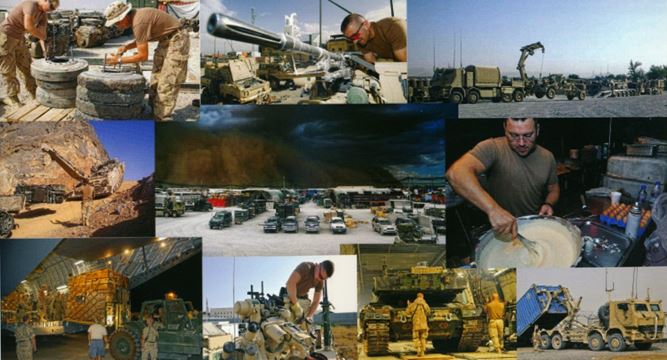By LCol Mike Hendrigan, CD (Retired)
Here is a humorous book about Logistics over the decades as told by those who were there (or not, as the case may be).
In the dynamic supply chain environment, people have to make the quick and decisive actions against various issues. This can only be achieved by the knowledge and skills of the team. Then companies try to motivate staff to continue developing their skills on a regular basis. For both entry and executives, the self-study method has proven to be a cost-effective option. In order to facilitate the smooth learning process, this article will show you 10 greatest supply chain management books that can help you accelerate the learning.
Read the book review.
This book is somewhat unique in the emerging canon of history of the Canadian engagement in Afghanistan, in that it focuses on logistics support to Task Force Orion from the perspective of the commander of the National Support Element. Conrad is forthright in his assessment of the challenges and lessons learned from a combat support tasking significantly different to that point in time from any previously experienced by the Canadian Forces. In particular, he examines what he refers to as “nearly 40 years of intellectual neglect of combat logistics by the Canadian Forces”. He makes the case that this neglect nearly caused the failure of sustainment of Task Force Orion, and required ad hoc responses to combat conditions and sustainment requirements not addressed in current doctrine.
The idea that logistics is not necessarily considered a priority by the combat arms which rely on it for success is not new, but is not often discussed publicly or dispassionately. To do so presents the challenge of identifying and addressing a problem that might have significant potential for disaster in military operations, while at the same time not being accused of mere whining. It will be interesting to learn from the collected experience of our membership what you think of this issue: is there an elitist attitude on the parts of the combat arms vis a vis Logistics? If so, could this adversely affect the assignment of sufficient resources for adequate logistics support? Does this attitude prevail in all operational environments; i.e. navy, army and air force? What can we, as Logisticians, do about it?
By February 2006, the focus of Canada’s military effort in Afghanistan had traversed from the relatively stable central region of Kabul to Kandahar province as the Canadian-led Multinational Brigade conducted a “relief in place” with the US 173 Airborne Task Force Bayonet, and assumed responsibility for the volatile area known as Regional Command South (RC South). Canadian military leadership in Ottawa enthusiastically embraced the opportunity to assume this leadership role within the NATO community, yet from their earliest meetings with their American counterparts at Kandahar Airfield (KAF), it was apparent to the leadership on the ground that this operation was different and much more dangerous than anything in Canada’s recent history.
“I will never forget the electric sense of shared enterprise between Lieutenant-Colonel Ian Hope and myself as we returned to Afghanistan in October 2005 to begin the final preparations for the mission in Kandahar. Were we really going to be taking our units, Canadian battalions, into a war? It seemed impossible and yet the handover briefings from our American counterparts kept bringing us back to the inevitable truth. You could see this on every line of every one of their faces. It is dangerous here.”
— Lieutenant-Colonel John Conrad
What the Thunder Said: Reflections of a Canadian Officer in Kandahar, provides a very personal and dramatic account of the Canadian Army’s earliest experiences in southern Afghanistan. While the majority of historical documents on war and its devastation are offered from the perspective of the front-line soldiers and their battle-hardened leaders, this book by Lt-Col Conrad provides us with a brilliant and honest perspective of the unsung heroes of the modern-day battlefield – the logistics soldiers. As the commander of the National Support Element (NSE), Conrad takes us into the heart of his admittedly understaffed support organization, introducing us to some of his troops and sharing their most harrowing and personal experiences. At first glance, the reader may assume that this book is nothing more than a series of recollections and diary notes. However, Conrad uses this anecdotal approach to draw attention to the need for our military leaders to truly appreciate the role of logistics in modern-day conflict, an issue that has plagued our military since the end of the Korean War.
Conrad makes a bold yet accurate statement on the military’s attitude towards its support resources, the men and women of the logistics and medical trades. Despite their history of providing first- rate support with minimal resources, “…military logistics in the Canadian Forces is viewed as something less than merely non-elite. Military logistics in Canada is viewed with near disdain.” It is a statement that finally sets free the innermost thoughts and feelings of a generation of logisticians and support personnel, whose sole existence has been to ensure the success and survivability of those they serve. Yet, despite the years of neglect and less-than-equal treatment, Conrad demonstrates the depth of commitment and determination exercised each and every day as these soldiers laboured to provide the much-needed front line support.
The battlefield has changed drastically over the past two decades, and the traditional front and rear lines have been replaced with unpredictable attacks and random explosive devices that can take a life anywhere and at any time throughout the country. Conrad paints a vivid picture of the new challenges and dangers facing the support personnel as they venture out in slow-moving convoys through hostile territory to deliver supplies and to recover broken vehicles.
“The logistic soldier in Kandahar rides with passive optimism that he or she will come up swinging after the attack. But whether you live or die, whether you get to come up fighting, depends not on your physical fitness, your intellect, or your prowess with the rifle. Instead your survival hangs on such random factors as vehicle armour, proximity to the blast, and pure luck. Providence. That is hard to accept.”
Although a mere 239 pages long, What the Thunder Said includes a brief history of Canada’s military logistics and the vital lessons learned by some of our most successful and influential leaders. Lessons that have been forgotten through decades of budget cuts and disinterest are now resurfacing in dangerous and life-threatening scenarios on the battlefields of Afghanistan. Conrad stresses the urgent need for our leadership to become more active in understanding the vital role of logistics and the principles of support planning before the threads of support dissolve completely. The success of the NSE in Afghanistan is solely due to the courage and determination of its personnel to continue to achieve effects well out of proportion with its size and capabilities.
“My battalion, with its bland and non-sexy title of National Support Element (NSE), deployed to Afghanistan in February after nearly 40 years of intellectual neglect of combat logistics by the Canadian Forces. As it would turn out, sustaining Canada’s Task Force Orion in southern Afghanistan in 2006 would be a very near run thing: a brush with failure that was all too close.”
What the Thunder Said: Reflections of a Canadian Officer in Kandahar is a courageous and honest attempt by Conrad to acknowledge the accomplishments of the NSE support personnel during their time in Afghanistan, and to bring to the forefront the need for a significant change in attitude within the Canadian Forces. Whether being viewed by a frustrated logistician looking for change, or an inquisitive member of the combat arms, this book is an uncomplicated and engrossing read, recommended to round out any military educational reading list.

Afghanistan: A Canadian Story is a book that will serve as an Afghan mission legacy album and offer readers a chronological compilation of personal stories and photos from some 150 men and women who served in Afghanistan from the first deployment of the Royal Canadian Navy in October 2001 to the return of the last troops in March of 2014. The stories are accompanied by a brief history of Afghanistan and a description of the roles of the Canadian mission, including the various service elements and other departments of the Canadian government. The book provides a rare and human insight into many aspects of the boots on the ground experience of serving Canada in Afghanistan, and will be particularly appreciated by loggies because its many heartfelt personal remembrances include an emphatic shoutout from LCol Devon Matssalla which celebrates Combat Service Support as “The lifeblood of the task force”, and gives a detailed description of the many different and essential roles performed by Canada’s Combat Service Support specialists in theatre.
This book was a wholly private volunteer effort, with proceeds being donated to the Edmonton Military Family Resource Centre, the Boomers Legacy Foundation, the Military Families Fund, Operation Dignity St Anne de Bellevue Veterans Hospital Foundation, and the Soldier On Fund. The families of those who gave their lives during the mission have each been presented with a commemorative copy.
Previously published, Logistics Service Newsletter, Apr ’16
RCLSA Historical Reading List
Founding Corps Histories
- Sea Logistics: Keeping Canada’s Navy Ready Aye Ready. Author: Commander Mark Watson.
- Wait for the Waggon: The Story of the Royal Canadian Army Service Corps. Author: Arnold Warren.
- The Last Waggon: The Final Story of the Royal Canadian Army Service Corps. Author: Colonel J. Darrach Murray.
- To the Thunderer his Arms: The Royal Canadian Ordnance Corps.
Canadian Unit histories
- Le 51e Bataillion Des Serviced Du Canada (1901 – 2005). Author: Michel Litalien.
- United in Effort: Manitoba Combat Service Support History (1870 to 2015).
General Military Logistics
- Supplying War: Logistics from Wallenstein to Patton. Author: Martin Van Creveld.
- Feeding Victory: Innovative military logistics from Lake George to Khe Sanh. Author: Jobie Turner.
- The Lifeblood of War: Logistics in Armed Conflict. Author: Julian Thompson.
First World War
- Civilian Specialist at War – Britain’s Transport Experts and the First World War. Author: Christopher Phillips.
Second World War
- World War II Remembered: Memories and Recollections (Royal Canadian Army Service Corps).
- An Army of never-Ending Strength: Reinforcing the Canadians in Northwest Europe. Author: Arthur W. Gullachsen.
- Arnhem – The Fight to Sustain. Author: Frank Steer.
- The Gold Cross: One Man’s Window on the War. Author: David M. Dorward.
- Diary of 65 Canadian Tank Transporter Company (RCASC).
Afghanistan
- What the Thunder Said: Reflections of a Canadian Officer in Kandahar. Author: LCol John Conrad.
Other Conflicts
- Logistics in the Falklands War: A case study in expeditionary warfare. Author: Kenneth L. Privratsky.
- Moving Mountains: Lessons in leadership and logistics from the Gulf War. Author: LGen W. Pagonis.
Other References
- Badges of the Empire’s Waggoners. Author: Michael McHenry and David Kellock (Asst by Gary Campbell).
- The Box: How the Shipping Container made the World Smaller and the World Economy Bigger; Marc Levinson; Princeton University Press, Princeton, 2006; ISBN 978-0691-12324-0 (A history of the development and the impact of the shipping container).
- Uncommon Carriers; John McPhee (A discussion of a series of different and fascinating transportation technologies).
- Charlie Foxtrot; Dr Kim Richard Nossal; Dundurn Press, Toronto, 2016 (A discussion of the nature and the impacts of the politicization of military procurement programs in Canada, including a detailed discussion of several selected cases)
